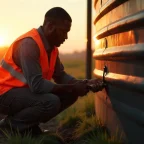Bathroom leakage is one of the most common and frustrating problems in homes and commercial buildings across Pakistan. Left untreated, it can lead to structural damage, mold growth, and increased water bills. At Brooks Chemical Services, we specialize in bathroom leakage repair using advanced techniques and long-lasting waterproofing solutions tailored for the Pakistani climate and infrastructure.
Common Causes of Bathroom Leakages in Pakistan
Understanding the root causes of leakages is the first step in effective repair. In Pakistan, the most frequent issues include:
Faulty Pipes and Drainage Systems
Aging or improperly installed pipes often develop cracks, leading to leaks. Poorly sealed joints in sewerage lines are a frequent culprit, especially in older buildings 513.
Cracked Tiles and Grout
Deteriorating grout and harsh cleaning chemicals allow water to seep into subflooring, necessitating bathroom leakage solutions like regrouting.
Toilet Seal Failures
A damaged wax ring or loose rubber gaskets around the toilet base can cause water to leak onto floors. Faulty flush valves or flappers in the tank also contribute to silent leaks 210.
Waterproofing Membrane Damage
Low-quality materials or improper installation during construction result in membrane failure, a critical issue addressed through bathroom leakage treatment like chemical injections.
Blockages in “P” traps or main sewer lines create pressure buildup, forcing water to escape through weak points in the plumbing system
Types of Bathroom Leakages
Bathroom leakages can occur in various parts of the space. Here’s a breakdown of the most common types:
- Floor leakages are one of the most common issues, usually caused by water seeping through tiles or grout lines. This often results from failed waterproofing membranes beneath the surface.
- Wall leakages appear as damp patches, paint peeling, or mold growth on adjacent walls. These are typically caused by internal pipe leaks or seepage from bathrooms on the other side of the wall.
- Toilet and drain leakages usually occur at the base of the toilet, around drain traps, or at pipe connections. Signs include visible puddles around the fixtures or persistent unpleasant odors.
- Shower and tap leakages often stem from leaks behind mixer valves or loose fittings. Over time, these can lead to structural damage behind tiles and walls if left untreated.
Professional Bathroom Leakage Repair Solutions
Brooks Chemical Services offers comprehensive bathroom leakage repair solutions without dismantling your bathroom tiles. Our process includes:
1. Chemical Injection Waterproofing
Our bathroom leakage chemical solutions involve injecting high-grade compounds into affected areas to seal water pathways—ideal for floors and walls without tile removal.
2. Pipe Leak Detection and Repair
Using thermal imaging and pressure testing, we pinpoint concealed leaks for precise repairs, minimizing disruption.
3. Regrouting and Tile Sealing
We replace damaged grout with waterproof sealants, a key bathroom leakage solution to prevent surface-level seepage.
4. Industrial-Grade Waterproof Coatings
For chronic issues, we apply robust coatings to form lasting moisture barriers—part of our bathroom leakage repair solutions for severe cases.
FAQs: Bathroom Leaks
Why does my bathroom keep leaking?
Bathroom leaks often recur due to:
- Worn-out seals or caulking around fixtures (tubs, showers, sinks).
- Cracked or loose tiles/grout, allowing water to seep into walls or floors.
- Faulty plumbing connections (e.g., loose pipe joints, damaged supply lines).
- Toilet leaks from a deteriorated wax ring or faulty flapper.
- Hidden structural issues, like slow pipe leaks or improper waterproofing under floors/walls.
If leaks persist after repairs, the source may not have been fully addressed, or there could be multiple issues.
How to find the source of a bathroom leak?
Follow these steps:
- Check visible areas:
- Inspect caulking/seals around showers, tubs, and sinks.
- Look for cracked tiles, mold, or water stains on walls/ceilings.
- Test the toilet:
- Add food coloring to the tank. If color appears in the bowl without flushing, replace the flapper.
- Check for wobbling or floor stains (sign of a damaged wax ring).
- Inspect plumbing:
- Examine pipes under sinks for drips or corrosion.
- Turn off water and monitor your meter—if it moves, there’s a hidden leak.
- Simulate water use:
- Run showers/sinks and check adjacent rooms for moisture.
- Professional tools:
- Plumbers use moisture meters or cameras to detect hidden leaks in walls/floors.
What is the most common bathroom leak?
The toilet wax ring failure is a frequent culprit, causing leaks at the base that damage floors. Other common sources include:
- Shower/tub leaks from cracked grout or worn caulking.
- Sink leaks from loose P-trap connections or worn supply lines.
- Dripping faucets due to worn-out washers or cartridges.
How do I stop my bathroom from leaking?
Fix based on the source:
- Reseal fixtures: Replace caulk/grout around showers, tubs, and sinks.
- Repair toilet leaks: Replace the wax ring (for floor leaks) or flapper (for tank leaks).
- Tighten plumbing: Secure loose pipe connections or replace corroded pipes under sinks.
- Waterproofing: Reapply waterproof membrane under tile floors/walls if needed.
- Professional help: For persistent or structural leaks (e.g., slab leaks, damaged subflooring).
Prevent future leaks:
- Regularly inspect and maintain seals/grout.
- Avoid harsh cleaners that degrade caulk.
- Address minor issues before they worsen.
Get Reliable Bathroom Leakage Repair in Pakistan
Don’t wait for a minor leak to become a major headache. Whether it’s your home, office, or commercial building, Brooks Chemical Services offers expert bathroom leakage repair in Pakistan with proven results.
Contact us today via brooks.pk to schedule a site inspection or get a free quote.








